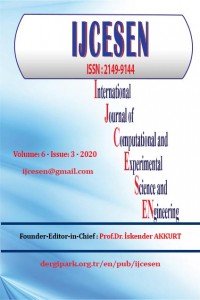Abstract
References
- [1] Kumar, N., Rao, V.V. “Hyperelastic Mooney-Rivlin Model : Determination and Physical Interpretation of Material Constants” MIT International Journal of Mechanical Engineering, 6, 1(2016)43–46.
- [2] M. C. Boyce, E. M. Arruda, "Constitutive models of rubber elasticity: A review" Rubber Chemistry and Technology.73,3(2000)504–523,DOI: https://doi.org/10.5254/1.3547602
- [3] B. Kim, S. B. Lee, J. Lee, S. Cho, H. Park, S.Yeom, , S. H. Park, A comparison among Neo-Hookean model, Mooney-Rivlin model, and Ogden model for Chloroprene rubber. International Journal of Precision Engineering and Manufacturing, 13,5(2012)759–764. https://doi.org/10.1007/s12541-012-0099-y
- [4] M. Mooney, "A Theory of Large Elastic Deformation" Applied Physics,11,(1940)582. https://doi.org/10.1063/1.1712836
- [5] Anonim 2019. Abaqus 6.14 Documentation. http://ivt-abaqusdoc.ivt.ntnu.no:2080/texis/search/?query=wetting&submit.x=0&submit.y=0&group=bk&CDB=v6.14.
- [6] H. Menderes, and A. W. A. Konter, “Advanced FE Analysis of Elastomeric Automobile Components under Realistic Loading Conditions,” Proceedings of the First European Conference on Constitutive Models for Rubber, pp. 3-12 (1999).
- [7] Y. Wu, H.Wang and A. Li, "Parameter Identification Methods for Hyperelastic and Hyper-Viscoelastic Models" Applied Sciences, 6,12-386(2016)1-13. https://doi.org/10.3390/app6120386
- [8] D. J.Charlton, J.Yang, K. K. Teh,. "A Review of Methods to Characterize Rubber Elastic Behavior for Use in Finite Element Analysis" Rubber Chemistry and Technology,67,3(1994)481–503. https://doi.org/10.5254/1.3538686
- [9] R.S. Rivlin, "Large Elastıc Deformatıons. Rheology: Rheology", Academic Press, (1956) 351–385. https://doi.org/10.1016/B978-0-12-395694-1.50016-6
- [10] D.C. Drucker “A definition of a stable inelastic material”, J. Appl. Mech.,26 (1959) 101–106.
Abstract
The finite element studies of hyperelastic materials always need founding a mathematical model describes the behavior of their elements. Several constitutive models differ in matching accuracy, can describe the behavior of hyperelastic material, such as Neo-Hookean, Yeoh, and Mooney-Rivlin, which are all derived from the strain energy density function.
Founding a mathematical model describing the behavior of some hyperelastic material means the determination of the constitutive model's invariants, which are considered as material parameters.
In this work, the two-parameter Mooney-Rivlin model was chosen to demonstrate the procedure of forming the mathematical model that describes the mechanical behavior of an incompressible hyperelastic material. Comparing with those results taken from Abaqus, obtained results were very close and exhibited a lower absolute error. This procedure can be considered as a general method to describe the hyperelastic materials by the other polynomial constitutive models.
Keywords
References
- [1] Kumar, N., Rao, V.V. “Hyperelastic Mooney-Rivlin Model : Determination and Physical Interpretation of Material Constants” MIT International Journal of Mechanical Engineering, 6, 1(2016)43–46.
- [2] M. C. Boyce, E. M. Arruda, "Constitutive models of rubber elasticity: A review" Rubber Chemistry and Technology.73,3(2000)504–523,DOI: https://doi.org/10.5254/1.3547602
- [3] B. Kim, S. B. Lee, J. Lee, S. Cho, H. Park, S.Yeom, , S. H. Park, A comparison among Neo-Hookean model, Mooney-Rivlin model, and Ogden model for Chloroprene rubber. International Journal of Precision Engineering and Manufacturing, 13,5(2012)759–764. https://doi.org/10.1007/s12541-012-0099-y
- [4] M. Mooney, "A Theory of Large Elastic Deformation" Applied Physics,11,(1940)582. https://doi.org/10.1063/1.1712836
- [5] Anonim 2019. Abaqus 6.14 Documentation. http://ivt-abaqusdoc.ivt.ntnu.no:2080/texis/search/?query=wetting&submit.x=0&submit.y=0&group=bk&CDB=v6.14.
- [6] H. Menderes, and A. W. A. Konter, “Advanced FE Analysis of Elastomeric Automobile Components under Realistic Loading Conditions,” Proceedings of the First European Conference on Constitutive Models for Rubber, pp. 3-12 (1999).
- [7] Y. Wu, H.Wang and A. Li, "Parameter Identification Methods for Hyperelastic and Hyper-Viscoelastic Models" Applied Sciences, 6,12-386(2016)1-13. https://doi.org/10.3390/app6120386
- [8] D. J.Charlton, J.Yang, K. K. Teh,. "A Review of Methods to Characterize Rubber Elastic Behavior for Use in Finite Element Analysis" Rubber Chemistry and Technology,67,3(1994)481–503. https://doi.org/10.5254/1.3538686
- [9] R.S. Rivlin, "Large Elastıc Deformatıons. Rheology: Rheology", Academic Press, (1956) 351–385. https://doi.org/10.1016/B978-0-12-395694-1.50016-6
- [10] D.C. Drucker “A definition of a stable inelastic material”, J. Appl. Mech.,26 (1959) 101–106.
Details
| Primary Language | English |
|---|---|
| Subjects | Engineering |
| Journal Section | Research Articles |
| Authors | |
| Publication Date | November 30, 2020 |
| Submission Date | December 20, 2019 |
| Acceptance Date | November 11, 2020 |
| Published in Issue | Year 2020 Volume: 6 Issue: 3 |


